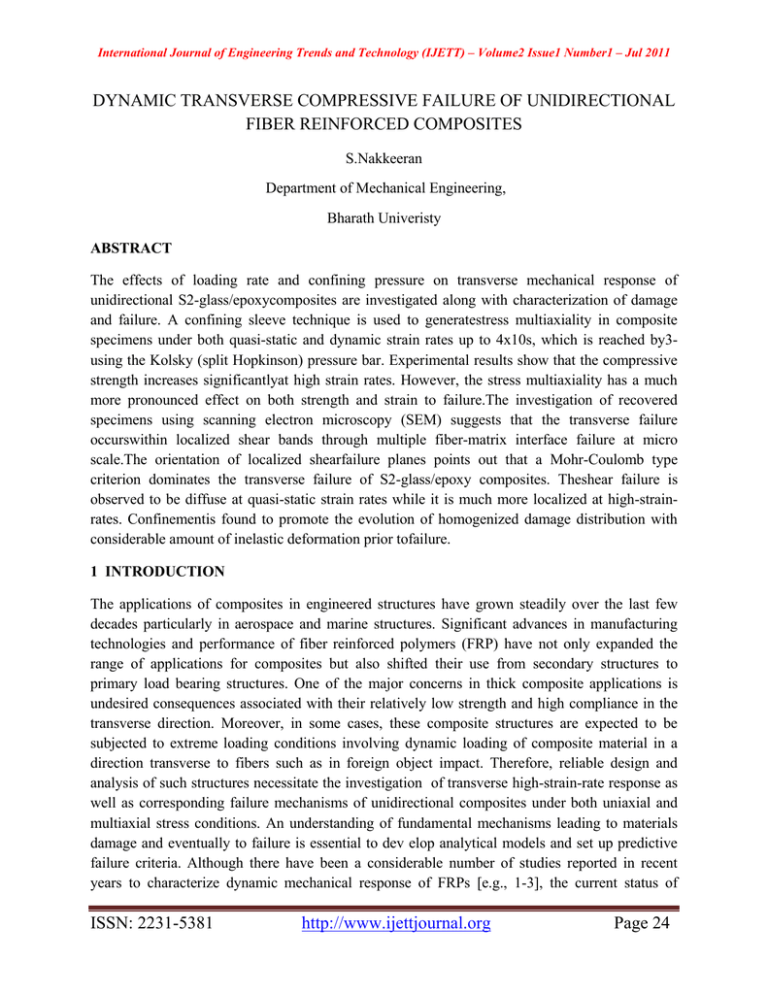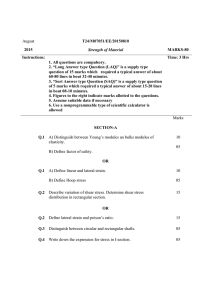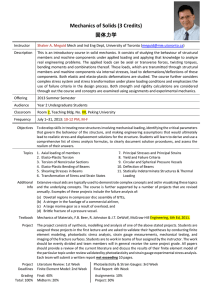Document 12932516
advertisement

International Journal of Engineering Trends and Technology (IJETT) – Volume2 Issue1 Number1 – Jul 2011 DYNAMIC TRANSVERSE COMPRESSIVE FAILURE OF UNIDIRECTIONAL FIBER REINFORCED COMPOSITES S.Nakkeeran Department of Mechanical Engineering, Bharath Univeristy ABSTRACT The effects of loading rate and confining pressure on transverse mechanical response of unidirectional S2-glass/epoxycomposites are investigated along with characterization of damage and failure. A confining sleeve technique is used to generatestress multiaxiality in composite specimens under both quasi-static and dynamic strain rates up to 4x10s, which is reached by3using the Kolsky (split Hopkinson) pressure bar. Experimental results show that the compressive strength increases significantlyat high strain rates. However, the stress multiaxiality has a much more pronounced effect on both strength and strain to failure.The investigation of recovered specimens using scanning electron microscopy (SEM) suggests that the transverse failure occurswithin localized shear bands through multiple fiber-matrix interface failure at micro scale.The orientation of localized shearfailure planes points out that a Mohr-Coulomb type criterion dominates the transverse failure of S2-glass/epoxy composites. Theshear failure is observed to be diffuse at quasi-static strain rates while it is much more localized at high-strainrates. Confinementis found to promote the evolution of homogenized damage distribution with considerable amount of inelastic deformation prior tofailure. 1 INTRODUCTION The applications of composites in engineered structures have grown steadily over the last few decades particularly in aerospace and marine structures. Significant advances in manufacturing technologies and performance of fiber reinforced polymers (FRP) have not only expanded the range of applications for composites but also shifted their use from secondary structures to primary load bearing structures. One of the major concerns in thick composite applications is undesired consequences associated with their relatively low strength and high compliance in the transverse direction. Moreover, in some cases, these composite structures are expected to be subjected to extreme loading conditions involving dynamic loading of composite material in a direction transverse to fibers such as in foreign object impact. Therefore, reliable design and analysis of such structures necessitate the investigation of transverse high-strain-rate response as well as corresponding failure mechanisms of unidirectional composites under both uniaxial and multiaxial stress conditions. An understanding of fundamental mechanisms leading to materials damage and eventually to failure is essential to dev elop analytical models and set up predictive failure criteria. Although there have been a considerable number of studies reported in recent years to characterize dynamic mechanical response of FRPs [e.g., 1-3], the current status of ISSN: 2231-5381 http://www.ijettjournal.org Page 24 International Journal of Engineering Trends and Technology (IJETT) – Volume2 Issue1 Number1 – Jul 2011 experimental database in the field does not allow making generalized assessments on the effect of strain rate since there is a significant discrepancy in the reported trends. It app ears that the intrinsic nature composite materials introduce substantial complexity in the interpretation and generalization of test results mainly due to the factors such as anisotropic mechanical response and numerous matrix-fib er and stacking sequence combinations u sed in general practice. Similar to the investigations at high- strain-rates, studies on the mechanics and failure of transversely loaded unidirectional composites has been relatively limited, with even less on the effects of stress multiaxiality. The objective of present work is to report on the results of an experimental effort towards the better understanding of unidirectional composite response under transverse loading conditions, particularly at high-strain-rates. Mechanical response and failure behavior an S2glass/epoxy composite is characterized under both quasi-static and dynamic strain rates and under varying degrees of lateral confinement. 2 EXPERIMENTAL PROCEDURE A unidirectional S2-glass/epoxy composite plate of the dimensions 254x355x5.8 mm and with the nominal fiber volume fraction of 65 % was used to machine cylindrical specimens. The specimens with oversized diameter were first cut from the composite plate using a carbide tipped saw and further machined on a lathe down to the desired diameter. The parallel surfaces of specimens were polished using 320 and 600 grit sand papers prior to testing. The final specimen dimensions were typically 9.5 ± 0.05 mm in diameter and 5.6 ± 0.05 mm in length, corresponding to a length to diameter ratio of ~0.6. Experiments were conducted over a wide range of strain rates from 10 to 4 and under varying degrees of lateral of confinement using the methods described in the following. All the test results reported in this study are for the specimens loaded perpendicular to fiber axis, i.e., transverse loading. Quasi-static compression of specimens was performed using a compression fixture to ensure that the loading rods were perfectly aligned with each other so that any unwanted shear forces on the specimen are minimized. The specimen was sandwiched in between the loading rods and a servo-hydraulic materials testing system (MTS, model 319.25) was used to apply compression. Varying the cross-head displacement rate allowed the application of strain rates in the range from 10 to 10 s . Deformation data of specimens was obtained from the crosshead displacement -4 0 -1 transducer, which was calibrated to eliminate the machine and fixture compliance effects. Testing of composite specimens at high-strain-rates was performed using a Kolsky (split Hopkinson) pressure bar. Kolsky (split Hopkinson) pressure bar has been widely used and modified to measure the dynamic compressive behavior of engineering materials. A detailed review of the technique and the data reduction procedures can be found in elsewhere [4]. The dimensions of the bars in Kolsky pressure bar setup used in this study are 1215 and 1020 mm in length for the incident and transmission bars respectively, with a common diameter of 19.05 mm. The striker bars of 19.05 mm diameter were used with varying lengths to achieve desired pulse duration. All the bars are made of precision ground high strength C350 maraging steel. To investigate the effect of stress multiaxiality on transverse mechanical response as well as on failure behavior of composite specimens, confinement sleeves were used in both quasi-static ISSN: 2231-5381 http://www.ijettjournal.org Page 25 International Journal of Engineering Trends and Technology (IJETT) – Volume2 Issue1 Number1 – Jul 2011 and dynamic tests. The confinement sleeve is a hollow cylinder which resists the lateral expansion of the specimen during axial compression. The materials and the dimensions of the confinement sleeves are varied to achieve desired degree of radial confinement. The experimental setup for the confined tests consists of a cylindrical composite specimen placed in the confinement sleeve with a sliding fit and the specimen is axially compressed using the loading rods, which is high strength C300 maraging steel, and tungsten carbide inserts. This technique provides a uniform lateral confinement pressure that is proportional to axial loading for isotropic materials and for transversely isotropic composites loaded along the fiber axis [5]. However, for composite materials compressed along the transverse direction, lateral expansion (or radial strains) is highly directional and, therefore, the lateral stress (s) exerted by c confinement sleeve to the specimen is far from being uniform. This situation makes the analysis and, thus, the quantification of confinement pressure very difficult due to non-uniform hoop strain distribution along the periphery of confinement sleeve. 3 RESULTS AND DISCUSSION The mechanical response of transversely loaded S2-glass/epoxy composite is shown in Fig. 1 as a function of both loading rate and confining pressure. Un confined test results represent the uniaxial compression behavior of specimens while confined tests correspond to multiaxial stress state with proportional lateral confinement. The use of confinement sleeves with different materials and varying dimensions as enables reaching several distinct stress states within specimens that fall into the range between uniaxial stress and uniaxial strain conditions. It is apparent from Fig. 1 that the confining pressure has a significant effect on both the maximum stress attained and strain to failure. The higher is the lateral confinement, or resistance to lateral displacements, the higher is the strain to failure and flow stress at a certain strain. The strain to failure is defined as the strain beyond which the stress experiences a sudden drop. For quasi-static strain rates, its average value increases from 3.5 % for unconfined specimens to 37 % for specimens under weak confinement. For medium and strong confinements, failure, as definedabove, is not observed within the range of strains applied up to 50 %. The strain rate depen dency of strain to failure under confinement could not be determined because the failure is not observed at high-strain-rates for the range of strains imposed on the specimens. Independent of the rate of loading applied, compressive strength is fairly well defined in unconfined tests, which is the initial peak stress followed by catastrophic failure and associated stress drop. However, under confinement the catastrophic failure is suppressed and the transv erse material response is similar to strain hardening behavior though the situation is more complex at h igh-strain-rates. Therefore, for specimens lacking an initial peak stress, the compressive strength is defined as the stress at th e intercept of the stress-strain plot an d the line drawn parallel to the initial elastic loading path with 1 % strain offset. This definition is used only for quasi-statically loaded confined specimens (see Fig. 1(a)) since the confined specimens under dynamic loading shows a characteristic behavior with well defined peak stresses (see Fig. 1(b)). Unlike the quasi-static response, the dynamic response of composites under confinement shows a premature yielding followed by a ISSN: 2231-5381 http://www.ijettjournal.org Page 26 International Journal of Engineering Trends and Technology (IJETT) – Volume2 Issue1 Number1 – Jul 2011 steep strain hardening and then the peak stress. An explanation of this dissimilar behavior between quasi-static and dynamic loading is suggested based on the strong strain-rate sensitivity of Young’s modulus. As can bee seen from Fig. 1(c), comparison of static vs. dynamic response, and (d) variation of peak strength as a function of strain rate and confinement. independent of the degree of confinement, Young’s modulus increases from around 8 GPa at quasi-static strain rates As a result of this stiffening, i.e., since yielding starts at a lower strain under high-strain-rate loading than under quasi-static loading, lateral strains at the time of yielding are also lower. This situation leads to lower confinement stress and experimentally observed premature yielding until the lateral strains are large enough to induce higher confinement stress and, thus, steep strain hardening. This relatively short strain hardening period is closely related to inelastic deformation of matrix material and followed by a maximum peak stress and, then, strain softening which is the indication of localized shear failure that will be discussed later in the context of failure modes. It should be noted at this point that the compressive displacement of specimens was measured using the crosshead displacement transducer at quasi-static strain rates as described in the section on experimental methods. Therefore, the accuracy in the measurement of small strains is limited. In a similar way, small strain data obtained from Kolsky pressure bar technique is generally approached with caution due to concerns about the establishment of dynamic stress equilibrium at the initial stage of compression that corresponds to elastic loading regime. For this reason, the Young’s moduli reported above for quasi-static and dynamic response should be viewed as approximate values, rather than exact, used only for the comparison purposes. The observation that the progressive inelastic deformation under confinement occurs at a lower stress level for dynamic loading than for quasi-static loading is noteworthy in the stress-strain plots of Fig. 1(c). The strain softening at high strain rates may be attributed to thermo mechanical couplings. During deformation, a significant part of inelastic strain energy is converted to heat and due to the dynamic nature of loading and there is not enough time for heat dissipation, i.e., heating occurs practically under adiabatic conditions. Unlike quasi-static deformation, this adiabatic heating during dynamic deformation can lead to significant temperature rise in composite materials. Furthermore, once the deformation is localized higher temperature increase is expected at the sites of localization. As a result, adiabatic heating and associated thermal softening in matrix material seem to be a reasonable explanation for the strain-rate softening observed in Fig. 1(c). Figure 1(d) gives an overall summary of the effects of strain rate and confinement on the compressive strength of S2-glass/epoxy composites. Increasing the strain rate from 10 to 10 s results in an increase in the transverse compressive strength by a factor of approximately 1.5. It should be noted that the strain-rate sensitivity of Young’s modulus, which gives a factor of 2.25, is significantly higher than that of compressive strength. The results also show that, depending on the degree of confinement, multiaxial state of stress may have much stronger effects on the transverse compressive strength of composites. For instance, medium confinement increases the compressive strength by a factor of 3 at quasi-static strain rates. The investigation of recovered specimens was performed using scanning electron microscopy (SEM) to gain insight on the evolution of damage and failure process. Figure 2 shows the typical SEM micrographs of ISSN: 2231-5381 http://www.ijettjournal.org Page 27 International Journal of Engineering Trends and Technology (IJETT) – Volume2 Issue1 Number1 – Jul 2011 thespecimens that were compressed up to various strains as designated in the captions. It should be recalled from Fig. 1 that un confined specimens fail in a catastrophic way exhibiting sudden stress drops, which corresponds to the formation of localized shear failure as shown in Fig. 2 (a). Figure 2(b) show the characteristic features of quasi-static progressive deformation under confinement. As the deformation proceeds, the number of localized shear bands increases and the damage distribution becomes relatively more distributed and homogeneous. After a certain deformation these localized bands start broadening with extensive matrix. Under dynamic loading, damage evolution in confined specimens seems to follow a different path. In this case, contrary to relatively homogeneous distribution under quasi-static loading, damage tends to grow around initial shear failure. The tendency of damage to remain localized in dynamic loading as seen Fig. 2(c) may be related to severe thermal softening along the initial shear bands due to adiabatic heating. Unconfined Medium confinement Figure 2: Typical SEM micrographs of recovered S-glass/epoxy specimens. The specimens were loaded along the top-to-bottom direction in the plane. Fiber direction is normal to the plane. Numerous measurements made on the angle of localized shear bands suggest that the transverse failure of unidirectional S2-glass/epoxy composites is governed by normal stress dependent Mohr-Coulomb type criterion. The angles between the failure planes and the loading surface were measured by using the SEM micrographs. The orientation of shear failure bands was found to scatter over the range 49° to 60° for all the specimens inspected, with the average angle being 53° . These findings are consistent with other observations made for a variety of fiber- reinforced polymeric composites [6] where it is reported that the orientation of failure planes in transversely compressed composites are highly scattered in the range from 49° to 55°. Therefore, based on the orientation of localization bands, transverse failure can be defined to occur when the shear stress at a particular plane reaches a critical value which is a function of normal stress acting on the plane. Where and are the shear stress and the normal stress components acting on the failure plane, respectively, 0 is the cohesive shear strength in the absence of normal stress and is a parameter related to the normal stress dependence which is often defined as the coefficient of internal friction. The average angle of 53° between the failure plane and the loading surface of specimen corresponds to 0.29 and 75 MPa for a quasi-stat ISSN: 2231-5381 http://www.ijettjournal.org Page 28 International Journal of Engineering Trends and Technology (IJETT) – Volume2 Issue1 Number1 – Jul 2011 3 CONCLUSIONS Transverse mechanical behavior of S2-glass/epoxy composites has been investigated with an emphasis on the effects of strain rate and lateral confinement. Experimental results show th at even though the compressive strength significantly increases at high strain rates the stress multiaxiality has a much more pronounced effect on both strength and strain to failure. The SEM observations suggest that macroscopic transverse failure is dominated by shear stresses and occurs within localized bands through multiple fiber-matrix interface failure at micro scale. The orientation of shear failure bands suggests that a Mohr-Coulomb type criterion dominates the transverse failure of S2-glass/epoxy composites. In order to investigate the effect of stress multiaxiality on mechanical response, experiments have been performed with varying degrees of lateral confinement. Results show that the compositesunder confinement show significant increases in strength and strain to failure and experience relatively more distributed and homogeneous damage with considerable amount of inelastic deformation. The experimental results presented here can potentially be used to discriminate between various models that have been proposed as failure criteria for fiber reinforced composites. 4 ACKNOWLEDGEMENTS This research was supported Proffessor S.Nakkeeran , HOD , Mechanical Engineering Department and is gratefully acknowledged. The authors thank Professor Jose Anadh Vino for kindly providing the composite material used in this study. ISSN: 2231-5381 http://www.ijettjournal.org Page 29 International Journal of Engineering Trends and Technology (IJETT) – Volume2 Issue1 Number1 – Jul 2011 5 REFERENCES 1. Thiruppukuzhi, S.V. and Sun, C.T., “Testing and Modeling High Strain Rate Behavior of Polymeric Composites”,, Vol. 29, No. 5, pp. 535-546, (1998). 2. Oguni, K. and Ravichandran, G., “Dynamic Compressive Behavior of Unidirectional EGlass/Vinylester Composites”, Vol. 36, pp. 831-838, (2001) 3. Sierakowski, R.L., “High Strain Rate Effects in Composites”, Vol. 50, No. 12, pp. 741-761, (1997). 4. Gray, G. T., III, “Classic Split Hopkinson Bar testing”, ASM International, Metals Park, OH, Vol. 8, pp. 462-518, (2000). 5. Oguni, K., Tan, C.Y., and Ravichandran, G., “Failure Mode Transition in Unidirectional EGlass/Vinylester Composites Under Multiaxial Compression”, Vol. 34, No. 24, pp. 2081-2097, (2000). 6. Bazhenov, S.L. and Kozey, V.V., “Transversal Compression Fracture of Unidirectional FibreReinforced Plastics”, Vol. 26, pp. 2677-2684, (1991). ISSN: 2231-5381 http://www.ijettjournal.org Page 30




